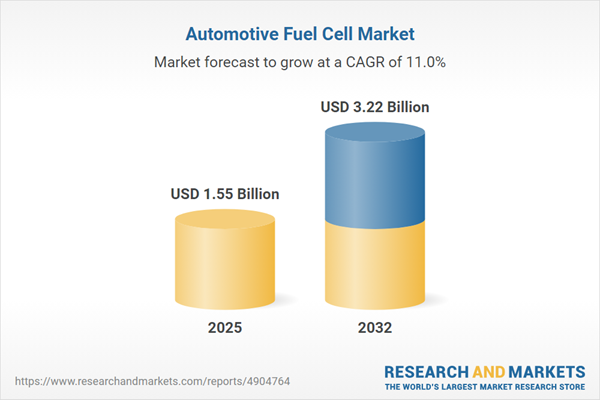Speak directly to the analyst to clarify any post sales queries you may have.
The automotive fuel cell market is undergoing rapid transformation, driven by escalating demand for zero-emission vehicles, ongoing technological advancements, and increased collaboration among stakeholders across the global mobility ecosystem. Senior leaders must now re-evaluate strategies to capture emerging opportunities and mitigate shifting regulatory and supply chain risks in this evolving landscape.
Market Snapshot: Automotive Fuel Cell Market Trends and Growth
The Automotive Fuel Cell Market grew from USD 1.39 billion in 2024 to USD 1.55 billion in 2025. It is expected to continue expanding at a CAGR of 11%, reaching USD 3.22 billion by 2032. This robust growth reflects an increasing shift towards sustainable transport, underpinned by regulatory pressures, escalating consumer awareness, and innovations in hydrogen infrastructure. The market is experiencing strengthened alliances among automakers, energy firms, and technology providers, collectively accelerating commercial deployments and infrastructure buildout. Regulatory tightening and the push for decarbonization are also intensifying investment flows and technological adoption worldwide.
Scope & Segmentation: Comprehensive Market Coverage
- Fuel Cell Types: Alkaline Fuel Cell (AFC), Phosphoric Acid Fuel Cell (PAFC), Proton Exchange Membrane Fuel Cell (PEMFC), Solid Oxide Fuel Cell (SOFC)
- Power Output: < 100 kW, 100–200 kW, > 200 kW
- Applications: Portable Power (consumer electronics, medical devices, military uses), Stationary Power (backup, primary generation, remote), Transportation
- End Use: Commercial Vehicles (heavy, light), Passenger Cars (hatchback, sedan, SUV)
- Sales Channel: Aftermarket, Original Equipment Manufacturer (OEM)
- Regional Coverage: Americas (North America, Latin America), Europe, Middle East & Africa (Europe, Middle East, Africa), Asia-Pacific (China, India, Japan, Australia, South Korea, Indonesia, Thailand, Malaysia, Singapore, Taiwan)
- Key Players: Toyota Motor Corporation, Hyundai Motor Company, Ballard Power Systems, Nuvera Fuel Cells, LLC, Honda Motor Co., Ltd., PowerCell Sweden AB, Hyzon Motors Inc., Intelligent Energy Limited, Plug Power, Doosan Fuel Cell Co., Ltd.
Key Takeaways for Decision-Makers
- Automotive fuel cell adoption is propelled by regulatory mandates and national policies incentivizing low-carbon solutions, placing pressure on supply chains and business models.
- Segment differentiation by fuel cell type and power output is sharpening, with distinct pathways emerging for passenger vehicles, commercial fleets, and portable power sectors.
- Advances in catalyst materials, membranes, and scalable system integration have overcome many early technical hurdles, positioning fuel cell vehicles as viable alternatives to battery electric and combustion engines.
- Strategic alliances between automakers, hydrogen producers, and infrastructure developers are bolstering the market, ensuring synchronized buildout of refueling networks alongside fleet rollouts.
- Sales and adoption patterns vary by region; Asia-Pacific leads commercialization, Europe emphasizes public funding and climate objectives, while the Americas pursue both infrastructure and renewable hydrogen development.
Tariff Impact on Supply Chains and Competitive Dynamics
Recent United States tariffs targeting automotive fuel cell components and modules are reshaping sourcing, driving domestic manufacturers to re-evaluate their supply strategies. These policies are catalyzing the strengthening of local supplier networks and vertical integration, while prompting import-dependent brands to pursue alternative material innovations and more resilient sourcing models. Collaboration and forward-looking supply chain strategies will be vital for sustaining competitive advantage amid shifting trade regulations.
Methodology & Data Sources
This report integrates primary stakeholder interviews with comprehensive secondary research from technical publications, government documents, company reports, and regulatory filings. Methodological rigor is maintained through scenario analysis, data triangulation, and advanced supply chain modeling to deliver relevant, actionable market insights.
Why This Report Matters to Senior Leaders
- Enables strategic planning by mapping the intersection of policy, technology, and market demand.
- Supports investment decisions with detailed segmentation and regional analysis across all market drivers.
- Delivers actionable intelligence for mitigating supply chain exposure and capitalizing on sustainable mobility trends.
Conclusion
The automotive fuel cell market offers growing opportunities amid regulatory change, technological maturity, and expanding infrastructure. Decision-makers equipped with in-depth insights from this report will be better positioned to lead through industry shifts and advance zero-emission transportation goals.
Additional Product Information:
- Purchase of this report includes 1 year online access with quarterly updates.
- This report can be updated on request. Please contact our Customer Experience team using the Ask a Question widget on our website.
Table of Contents
3. Executive Summary
4. Market Overview
7. Cumulative Impact of Artificial Intelligence 2025
Companies Mentioned
The companies profiled in this Automotive Fuel Cell market report include:- Toyota Motor Corporation
- Hyundai Motor Company
- Ballard Power Systems
- Nuvera Fuel Cells, LLC
- Honda Motor Co., Ltd.
- PowerCell Sweden AB
- Hyzon Motors Inc.
- Intelligent Energy Limited
- Plug Power
- Doosan Fuel Cell Co., Ltd.
Table Information
| Report Attribute | Details |
|---|---|
| No. of Pages | 189 |
| Published | October 2025 |
| Forecast Period | 2025 - 2032 |
| Estimated Market Value ( USD | $ 1.55 Billion |
| Forecasted Market Value ( USD | $ 3.22 Billion |
| Compound Annual Growth Rate | 11.0% |
| Regions Covered | Global |
| No. of Companies Mentioned | 11 |









